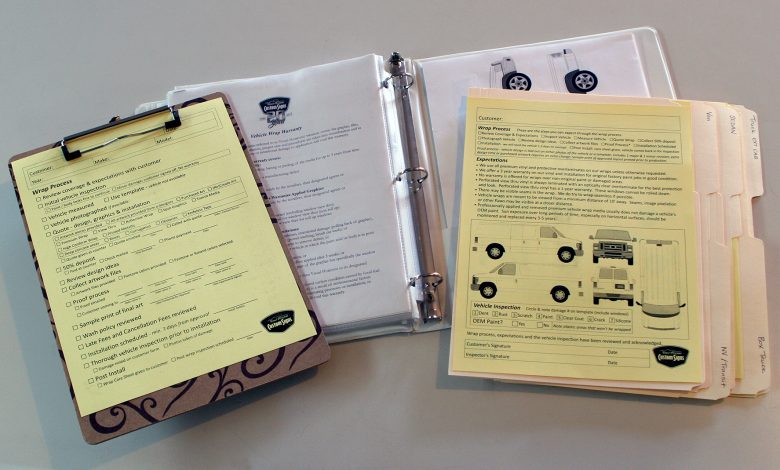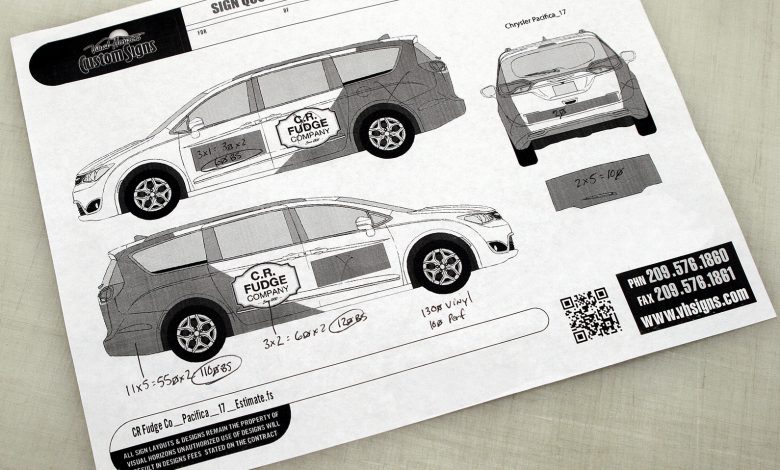Let’s Talk Shop: Wraps Pricing Strategies
There is a common formula for pricing wrap jobs-but there's more to it than that
I can’t even begin to count the number of vehicles I’ve quoted prices for over the last 15-plus years. Vans, cars, buses, box trucks, semi trailers, food trucks-the list of vehicle types goes on and on.
Each one shares a common formula for figuring out how to price the wrap, despite their many differences. Beyond these numbers though is a selling process that creates a relationship between you and your customer. This process is the true difference between creating a price and creating a relationship, between giving a quote and actually getting the job.
Customer Interview
We do get a fair share of customers who either already know exactly what they want because they’ve been quoting around and have already started working through the process, or they’ve just given it a lot of thought. But a majority of our potential customers are just learning about wrapping and the benefits it may offer their business.
I’ll get to the “common formula” we use for determining our wrap pricing in a minute, but this article, like most of our customer interactions, should really begin with the selling process. I like to call this the customer interview. This is where we find out what their needs are, the goals they hope to achieve and what their budget might be.
Needs and Goals
The customer’s needs and goals for the wrap really go hand in hand. For example, a small local bakery may need to increase year-round sales, beyond holidays and morning foot traffic, and they plan to do this by advertising their wedding cakes.
So, to meet this need, their goal with the vehicle wrap is to specifically target wedding cakes. Further, the goal with the advertisement should be that potential clients equate the bakery’s logo with wedding cakes and gather their contact information. Meeting this goal should in turn satisfy their need of increasing year-round sales.
Budget
Once we’ve established their needs and goals for the advertisement, we can start to think about coverage and design ideas to achieve this. A well-designed vehicle wrap can achieve successful results whether it’s a full wrap or a partial wrap.
This is where the customer’s budget comes into play. Unless the customer is trying to cover up the color of the vehicle or is wanting to make a specific statement with a full wrap, I don’t try to talk them into complete coverage.
We briefly explain the factors involved in determining a price, our “common formula,” and help them figure out how much they’re comfortable spending. Most people don’t start out with a hard number in mind because they don’t know what wraps cost, but by giving them rough numbers for a range of coverage options we’re able to come up with a price range that they can afford.
Selling
Notice that everything so far is about the customer. I’m not giving them a sales pitch about my company. I’m not cramming research numbers about consumer impressions and advertising costs for various media outlets down their throat.
At this point, it’s all about the client and what they need. This initial customer interview is our opportunity to create a relationship with the customer. It’s our chance to show them, not tell them, why our company is the one they should choose. And this happens before we’ve even given them a quote.
My goal is for the customer to spend a few minutes talking with me and to understand that:
- I’m interested in their success.
- I know what I’m talking about-I have the experience and knowledge to back up what I’m telling them.
- Our reputation has been built on our quality and customer service so I’ll be around for years to come because we’ll take care of them start to finish and into the future.
So how do you “show them” all of these things without “telling them”?
- You have lobby samples showcasing local projects you’ve completed.
- You have professional business cards and brochures sitting on the front counter.
- You have a website that contains more examples of your work that you can access with the customer.
- And these items surround the customer as they stand in your lobby talking to you.
You can continue to show them by the questions you ask, the experience you showcase by sketching out ideas that make sense and by having answers to the many questions they may have such as:
- What’s your warranty?
- What kind of wrap material do you use?
- Why do you recommend that material?
- I have this weird obstacle on my car, but I want to wrap this space, what would you suggest?
- I don’t have any high-resolution photos of my business, where can I get professional images?
You should be able to answer all these questions thoroughly. This is how you show, don’t tell. Nobody likes to feel like they’re being talked into something. Just answer the customer’s questions and guide them through the process and they will become comfortable with your company.
Common Formula
What I’m referring to as a “common formula” are the elements that go into determining the actual price for wrapping the customer’s vehicle. We break our wrap pricing into three areas: Design, Graphics and Installation.
We explain each part of this “common formula” to this customer when we give them the quote. We want them to know exactly what they’re getting for the price, and I think it adds value to the bottom line. “For X amount of money, we’re including all of this.”
This should be done in a simplified way. I know some companies will break it down into ink usage, material waste, man hours multiplied by the shop rate, etc. All this information does go into creating your price, but it’s too much specific information for the customer. Just give them a design amount (and what that includes), a total graphics price, and the installation price.
After we’ve discussed budget with the customer, we have a better idea of the coverage we can achieve within their price range. We also should have reviewed the vehicle and given them some ideas of how to best maximize their coverage based on the unique obstacles of their vehicle.
During the customer interview, we also ask about available artwork, how long they plan to leave the wrap on and what parts of the vehicle may need to be removed during installation. All these little bits of information are included on our wrap sales checklist and help us gather the information we need to work through the pricing formula.
Design
Over the years we’ve determined that we spend roughly four hours creating a custom template of the customer’s vehicle, typesetting support information, including a provided logo and incorporating any photos that are beneficial. We charge our shop rate times four hours as a base price for wrap design.
Because we do our best to gather as much information initially, including rough sketching ideas on a vehicle template with the customer, we don’t often have to make more than a couple revisions. If the customer changes direction with their ideas or makes excessive changes, then we communicate with them that additional charges will incur. We don’t want them to be surprised by extra charges and often the customer will make up their mind faster when it costs them more to drag it out.
Design costs beyond this base price are communicated up front. These would include logo design, artwork recreation and purchasing high-resolution artwork.
Graphics
The graphics pricing is determined by the total square footage of the vehicle that we plan to wrap. Vehicle template software is a great way to figure out square footage on common vehicles. Art Station’s Wrap Dimensions Guide is a handy tool for quickly figuring square footage, including windows.
Simply taking some quick measurements of the height and width of the areas works too. We typically note these measurements on a template printout or a quick sketch on one of our work orders. Be sure to include a few inches above and below the vehicle sizing since this will be the actual size of your print file.
If the graphics go up and around a window, and the window will also be wrapped with perforated view-thru vinyl, then we figure the total vinyl graphics square footage plus the total window square footage as these areas are essentially covered twice.
Once we’ve determined our square footage we then multiply this by our pricing rates. These rates are based on the material type, laminate used, and our shop overhead, which includes labor costs.
Sliding Scale
Over the years we’ve used online research and available sign pricing guides to determine what our shop overhead rate is and how this translates to a per-hour dollar amount. The shop rate we came up with has become a “mid-range” price on a sliding scale.
Basically, we have a price per square foot for premium wrap vinyl, transit or temporary vinyl, reflective wrap media, and perforated window film. If the area we’re covering is small, like a tailgate, then we add one to two dollars per square foot to our mid-range price. If we’re covering a large space, like a full van wrap or large trailer, then we drop the per-square-foot price by a dollar or two.
We’re going to spend nearly as much time at the front counter determining what the customer wants to include on the tailgate wrap and writing up the order as we would on most partial wraps. Upping the price per square foot on the lower coverage helps offset this extra time.
On larger projects, we’re selling a lot more coverage and our overhead is covered as we move past the mid-range square footage on the scale. By dropping the per square foot price a little we’re still able to make a profit while being competitive on our price.
Installation
Our shop determines an installation price based on an assessment of the vehicle and how many hours we think it will take to wrap the vehicle. Some shops will base their installation price on the square footage alone, but this does not take into account obstacles, compound curves, rivets, corrugations and other issues specific to that vehicle.
Wrapping a box truck with flat sides may take the same amount of time to wrap as a tiny smart car. If I was quoting on square footage alone I would lose money on my labor costs wrapping the smart car.
The more you wrap and gain experience the more accurate your installation prices will be. When you’re starting out you will be slower and may not be able to charge for the total time you put into the install. To gain customers and more experience you’ll have to be competitive. As you gain experience you’ll also increase your profits.
Other Considerations
Don’t overlook things that add extra labor and can eat into your installation profits. Consider the amount of time that will go into prepping the vehicle for wrapping. This includes removal of emblems and parts and cleaning thoroughly.
Rivets, corrugations and large protruding obstacles will also slow down the installation. This requires more time to properly prep and finish and this time needs to be added in.
Wrapping mirrors, door handles and trim pieces may be small, but they do require extra time to wrap correctly. Don’t throw these into the install because of their size. Stop and consider how long it will really take to wrap them and add in that time.
One more consideration is the material you’re working with. Some specialty color-change films require a bit of extra finesse for the best results. This involves careful handling and higher customer expectations on the finishing. This means you may move a little slower than on a commercial wrap.





